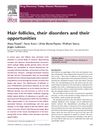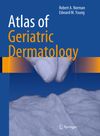TLDR The skin lesion was diagnosed as a matrical cyst with unusual features.
A skin lesion from a 10-year-old Samoyed dog was examined and diagnosed as a matrical cyst, despite not fitting perfectly into any known categories of follicular cysts or neoplasms. The lesion was a unilocular cyst with unusual features, including large squamous-like cells and an abundance of ghost cells. Differential diagnoses considered included acantholytic squamous cell carcinoma, tricholemmal cyst, and pilomatricoma, but these were excluded based on specific histopathological characteristics. The matrical cyst diagnosis was made due to the presence of large squamous cells, although this differed from the typical basaloid cell type usually associated with such cysts.
 7 citations
,
March 2017 in “Journal of dermatology”
7 citations
,
March 2017 in “Journal of dermatology” The conclusion is that accurately identifying folliculosebaceous tumors requires understanding their clinical signs and microscopic features.
 48 citations
,
May 2008 in “Drug Discovery Today: Disease Mechanisms”
48 citations
,
May 2008 in “Drug Discovery Today: Disease Mechanisms” Hair follicles offer promising targets for delivering drugs to treat hair and skin conditions.
53 citations
,
January 2013 in “Journal of toxicologic pathology” The project created a standardized system for classifying skin lesions in lab rats and mice.
 2 citations
,
January 2014 in “Springer eBooks”
2 citations
,
January 2014 in “Springer eBooks” The book details skin conditions in older adults, their link to mental health, cancer treatment importance, hair loss remedies, and managing autoimmune and itchy skin.
 November 2019 in “Harper's Textbook of Pediatric Dermatology”
November 2019 in “Harper's Textbook of Pediatric Dermatology” The document is a detailed medical reference on skin and genetic disorders.



